
The Debtors' Prison in Tappahannock, Virginia, is a historic debtors' prison dating back to the 18th century. Constructed sometime before 1769, it is one of three such structures remaining in Virginia, along with those in Accomac and Worsham. In the early 19th century, the practice of imprisoning debtors was abolished, marking a significant shift in societal attitudes towards debt and punishment. By 1820, the former prison had undergone a transformation, being repurposed into a residential space. The prison building is a contributing structure to the Tappahannock Historic District, and as such was listed on the National Register of Historic Places in 1973.

The C. Bascom Slemp Federal Building, also known as the Big Stone Gap Post Office and U.S. Post Office and Courthouse, is a historic courthouse and post office building located in Big Stone Gap, Wise County, Virginia. It was designed by the Office of the Supervising Architect under James Knox Taylor and built between 1911 and 1913. It is a three-story, seven-bay, stone building with a low hipped roof in the Second Renaissance Revival style. The front facade features a three-bay Tuscan order portico consisting of four pairs of coupled, unfluted columns. The building is named for Congressman C. Bascom Slemp.

Andrews Tavern is an historic building located in Spotsylvania County, Virginia. The original building was constructed for Samuel Andrews in 1815. Around 1848, a frame wing was added to the brick structure for a tavern. Though the wing was added to the original residence, there is no interior connection between the two. The tavern is an example of Federal provincial architecture.

US Post Office-Arlington is a historic post office building located in the Clarendon neighborhood of Arlington, Virginia. It was designed and built in 1937, and is one of a number of post offices designed by the Office of the Supervising Architect of the Treasury Department under Louis A. Simon. The building is a one-story, pentagonal shaped brick building in the Georgian Revival style. Atop the entrance portico is a dome that rises above the buildings flat roof and is supported by four fluted limestone piers. The interior features murals by Auriel Bessemer picturing Native Americans on Analostan Island, Captain John Smith and the Native Americans, tobacco picking by the Lee mansion, Robert E. Lee receiving his Confederate commission in Richmond, a picnic at Great Falls, polo players at Fort Myer, and a contemporary harvest at an apple orchard.

Brunswick County Courthouse Square is a historic county courthouse complex and national historic district located at Lawrenceville, Brunswick County, Virginia. It encompasses four contributing buildings and two contributing objects. They are the courthouse building, a clerk's office, library, jail, Confederate war monument, and a simple granite slab monument commemorating the county's veterans of World War I to the Vietnam War. Together they constitute a classic Southern courthouse square. The courthouse was built in 1854–55, as a two-story, gable-roofed rectangular brick building in the Greek Revival style. In 1939, a rear brick addition was completed, creating a T-shaped plan. The clerk's office is a two-story brick building built in 1893, with rear additions built in 1924 and 1939. The library was built in 1941.

Rapidan Historic District is a national historic district located at Rapidan, in Culpeper County and Orange County, Virginia. It encompasses 34 contributing buildings in the crossroads village of Rapidan. They include three churches, a post office, a commercial building, one meeting hall, two railroad depots, twenty-one residences, and six outbuildings. Notable buildings include the Emmanuel Episcopal Church (1874), "Annandale", the Rapidan Trading Post (1903), Rapidan Post Office (1914), Lower Rapidan Baptist Church (1914), Rapidan Passenger Depot, and the Peyton-Grhby House. Also located in the district is the separately listed Waddell Memorial Presbyterian Church.

US Post Office-Christiansburg is a historic post office building located at Christiansburg, Montgomery County, Virginia. It was designed and built in 1936, and was designed by the Office of the Supervising Architect of the Treasury Department under Louis A. Simon. The one-story, five-bay, brick building is in the Colonial Revival style. It features a denticulated cornice and a standing-seam metal, gabled roof surmounted by a small, flat-roofed cupola. The interior features a Works Progress Administration sponsored mural by Paul DeTroot, depicting local events of the French and Indian and Revolutionary wars.
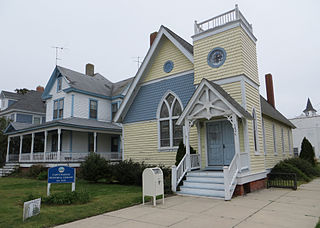
Cape Charles Historic District is a national historic district located at Cape Charles, Northampton County, Virginia. The Town was surveyed by the Virginia Department of Historic Resources in 1989, and a National Register Historic District was created and listed on the National Register of Historic Places.

Stuart Uptown Historic District is a national historic district located at Stuart, Patrick County, Virginia. The district includes 18 contributing buildings and 1 contributing object in the central business district of the town of Stuart. The district includes a variety of commercial and governmental buildings including the Stuart Post Office constructed by the Public Works Administration in 1940, the Patrick County Bank (1911), Bank of Stuart (1896), Stuart United Methodist Church and the Stuart Baptist Church. The district includes one and two-story brick commercial buildings dating from the early to mid 20th century including the Stuart Drug Store (1938) and the Hudson's Drug Store (1941). Located in the district and separately listed is the Patrick County Courthouse.
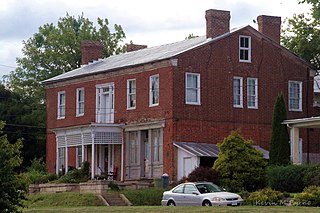
Edom Store and Post Office, also known as John Chrisman Store and Myers and Company, is a historic store and post office located at Edom, Rockingham County, Virginia. It was built about 1835, and is a two-story, brick commercial building. It features a metal-sheathed gable roof, a five-bay façade with center entries on the first and second stories, and a one-story entry porch and a storefront added in the late-19th century. It has a two-story rear ell. The interior is transitional Federal-Greek Revival. Also on the property is a contributing frame barn dated to about 1900. The Edom Post Office operated out of the store until the late 1930s and the store closed about 1940.
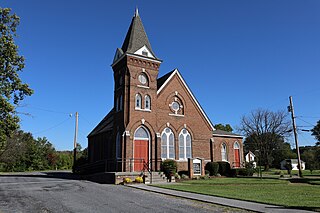
Riverton Historic District is a national historic district located at Front Royal, Warren County, Virginia. The district encompasses 66 contributing buildings and one contributing site in the town of Front Royal. It is a primarily residential district with buildings dating from the mid-19th century and including a diverse collection of building types and architectural styles. Notable buildings include Lackawanna (1869), the Old Duncan Hotel, the Riverton United Methodist Church (1883-1890), Dellbrook, the Carson Lime Company worker's houses, and the Old Riverton Post Office and Grocery. Located in the district and separately listed is Riverside.
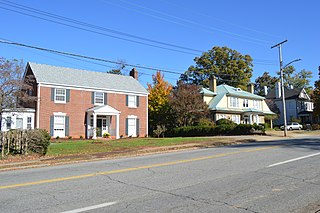
East Church Street–Starling Avenue Historic District is a national historic district located at Martinsville, Virginia. It encompasses 117 contributing buildings, 1 contributing structure, and 1 contributing object in a residential section of Martinsville. The buildings range in date from the range in date from the mid-1880s to the mid-1950s and include notable examples of the Tudor Revival and Colonial Revival styles. Notable buildings include the James Cheshire House, the Obidiah Allen House, John W. Carter House (1896), Christ Episcopal Church (1890s), G.T. Lester House or the “Wedding Cake House” (1918), John W. Townes House, Vaughn M. Draper House, and Martinsville High School (1940) and Gymnasium Building (1928). Located in the district are the separately listed John Waddey Carter House, Scuffle Hill, and the Little Post Office.

Old Norfolk City Hall, also known as the Seaboard Building and U.S. Post Office and Courthouse, is a historic city hall located at Norfolk, Virginia. It was built in 1898–1900, and is a three-story faced with rusticated stone and yellow brick in a Neo-Palladian Revival style. It features a central pedimented engaged portico with Corinthian order pilasters that contains the main entrance. The building housed a post office and Federal courts until they moved to the Walter E. Hoffman United States Courthouse about 1935. Title to the building was transferred from the U.S. government to the city of Norfolk in 1937, when it was converted into a city hall.
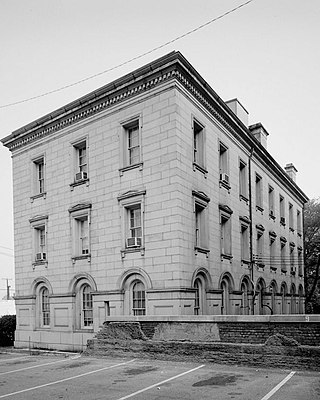
Petersburg City Hall is a historic city hall building located at Petersburg, Virginia. It was designed by architect Ammi B. Young and built between 1856 and 1859, as the U.S. Customs House and Post Office.
The West Broad Street Commercial Historic District is a national historic district located at Richmond, Virginia. The district encompasses 20 contributing buildings built between about 1900 and the late 1930s. Located in the district is the Forbes Motor Car Company (1919), Harper-Overland Company building (1921), Firestone Building (1929), Engine Company No. 10 Firehouse, and the Saunders Station Post Office (1937). The majority of the buildings are two-to-four stories in height and are composed of brick with stucco, stone and metal detailing. Located in the district is the separately listed The Coliseum-Duplex Envelope Company Building.

Salem Post Office, also known as the Old Post Office, is a historic post office building located at Salem, Virginia.

Downtown Salem Historic District is a national historic district located at Salem, Virginia. The district encompasses 34 contributing buildings and 1 contributing site in downtown Salem. The district includes primarily mixed-use commercial buildings, but also includes churches, dwellings, a courthouse, a post office, a library, a park, and the covered stalls of a farmer's market. The buildings mostly date from the late-19th and early-20th century and are in a variety of popular architectural styles including Greek Revival, Italianate, and Queen Anne. Notable buildings include the Stevens House or "Old Post House" (1820s-1830s), Kizer-Webber Building (1883-1886), Duval-Oakey House (1891-1898), Salem High School, Old Salem Municipal Building and Fire Department (1925), Quality Bakery Building, Olde Newberry Building (1929), Salem Theater, and James J. True Building (1927). Located in the district are the separately listed Old Roanoke County Courthouse, Salem Presbyterian Church, and Salem Post Office.

Beverley Historic District is a national historic district located at Staunton, Virginia. The district encompasses 131 contributing buildings in downtown Staunton. It is a compact commercial district characterized by a well-preserved collection of 19th-century buildings. The buildings are characteristically two- to four-story, brick structures in a variety of popular architectural styles including Romanesque Revival and primarily Italianate. Notable buildings include the old YMCA (1890), Hoover House Hotel (1893-1894), Putnam Organ Works Store (1894), City Hall, Odd Fellows Hall, U.S. Post Office (1936), and the Masonic Temple building (1895-1896). Located in the district are the separately listed National Valley Bank and Augusta County Courthouse.

Suffolk Historic District is a national historic district located at Suffolk, Virginia. The district encompasses 514 contributing buildings, 3 contributing structures, and 3 contributing objects in Suffolk. The district includes a variety of residential, commercial, governmental, and institutional buildings. They are in a variety of vernacular and popular 19th and 20th century architectural styles including Greek Revival, Queen Anne, and Bungalow. Notable buildings include the Allmond Building (1914), Macedonia A.M.E. Church, National Bank of Suffolk (1914-1920), the Old Post Office, old Nansemond County Courthouse, John Granberry house, Richard Seth Eley House (1878), Jones Building, Suffolk Towers, Virginia Apartments (1918-1920), Causey-Kendrick house (1882), Masonic Hall (1911), Suffolk High School (1922), Jefferson High School (1911), old Methodist Church (1861), St. Paul's Episcopal Church (1895), Suffolk Christian Church (1893), and Congregation of Agudath Achin. Located in the district are the separately listed Phoenix Bank of Nansemond, Professional Building, and Riddick House.

Glade Spring Commercial Historic District is the downtown core of the Town of Glade Spring, a community of 1,500 residents in northeastern Washington County, Virginia, less than three miles southwest of the Smyth County line. Located on the gently rolling floor of the Valley of Virginia, the town is surrounded by agricultural lands interspersed with clumps of woodland. The rugged southwest end of Walker Mountain is one mile to the northwest and Little Mountain four miles farther; the Iron Mountains define the opposite side of the Valley about seven miles to the southeast. On May 28, 2013, the "Town Square" was listed on the National Register of Historic Places.























